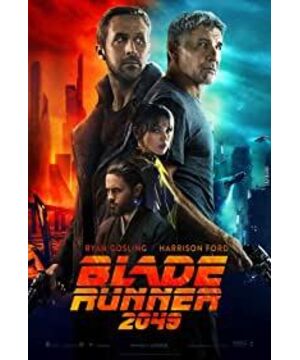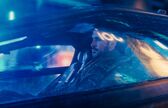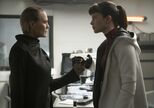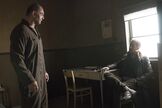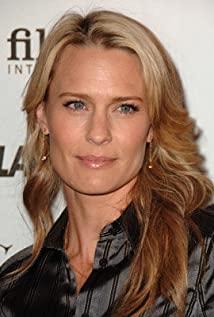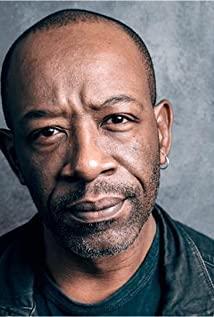The first "Blade Runner" is a classic "Future noir" (Future noir), which has been knocked down by countless papers. Some people regard it as a political fable, referring to the extreme schism between the elite and the poor in the future, and the replicators are interpreted as “slaves” or “immigrants without status”; there are also views that treat them as post-modern picture studies and copy The existence of human beings as the "perfect artwork" of human beings actually implies the desire of the creator, "mapping the flaws of human beings, the pursuit of perfection and the transcendence of physical limitations." (J.P.Telotte, 1983)
In the 1982 future world where truth and falsehood are obscure and mutually constrained, Deckard, the blade runner who spent his life hunting for "replicas," finally fell in love with Rachael and was rescued by his number one opponent Roy Batty, piled up under layers of material. The original poetic, sexy and childlike nature of "Human being a man"—the “highlight of the soul” in Rutger Hall's mouth—also made a sharp sound with the flying white dove. This dissolution of subjectivity and the continuous anxiety of people facing self-mirror are repeated in subsequent movies, from "The Sixth Day" and "Escape from the Island of Clone" to this year Ridley Scott's own "Alien" : The Contract, Matt Reeves's "Rise of the Apes 3: The Ultimate Battle", in the final analysis, are all of the same kind.
Blade Runner 2049's "apocalyptic picture" is even more empty and deserted: the "City of Angels" covered in blue light, Los Angeles continues to be dirty and rainy, San Diego has become a black garbage dump, and the sky is full of red and yellow sand and there is still a strong radiation of Las Vegas. Everywhere, life is dim, and people wear gas masks in the dense smog. This is the age when the last tree is dead, and humans need to rely on eating maggots to survive. It is imminent that reproduction and continuation are on the stage. The new question now is whether the mirror image (object) will break away from human control and replace the subject as a "better existence" if the copying person can multiply. He pushed the panic of mankind to one level.
The mystery left over from the previous work: "Is Deckard a copy?" has not yet been answered positively, and a new question has been raised: Is the encounter and love of Deckard and Rachael accidental? Because it is possible, this is a deliberate design by Tyler, the "father of clones", to hunt down four Nexus 6 clones at large, leading Deckard and Rachael to meet, a clone reproduction experiment, as a redemptive existence for mankind in the future .
The "color" that fills in the details of the story: K's five-color situation
The visual density and level of the movie are exciting. All spaces have obvious color divisions. If we look at the five steps of Kristin Thompson's narrative:
1) Set up: K "hunted" the Nexus8 Xie Bo (SapperMorton) hidden in the farmer's identity, found the skeleton, returned to the base for testing, and interacted with the virtual lover when he returned home (white + blue);
2) Complication action: Go to Wallace Group to investigate the data, the line index is to Deckard, where the number one angel Nexus9 copy person Luv appeared, San Diego garbage dump orphanage, and found that it overlaps with the scene in my memory (black + yellow);
3) Development: Look for Deckard (yellow) in Las Vegas, a strong radiation area;
4) Climax: The leader of the Nexus8 uprising legion subverted his recognition of his identity, and K decided to rescue Deckard from Luv (black + blue);
5) Epilogue: Lead Deckard to the Replica Human Memory Manufacturing Company to meet the memory weaver (white).
The colors themselves, which are intended to continue the previous work, also provide us with an emotional side to further interpret the plot.
White, to emphasize isolation. At the beginning of the “hunting” of Nexus8 Xie Bo in California, the space he lived in was the main color of bone-like gray, which coincided with his desire to be a farmer in isolation from the world, but the door to the living room was small and warm. Huang Guang, in line with the subsequent fate of Xie Bo still unable to escape being terminated by K. The space in which Dr. Anna, the memory weaver, a copy of the memory weaver, is located is almost pure white, even more “straightforwardly” isolated with glass, and the room where she works is also covered with snow. In fact, K’s residence is also slightly off-white, in addition to reflecting his identity as a copy of the middle and lower levels of the "tool", because (we will find out later) that he has in fact been under the supervision of the Wallace Group Nexus9 Terminator female killer Luv. The residence of this "BadDog" is also "white" (isolated) impure.
Yellow leads to the extremes of birth and destruction at the same time. In the opening scene, K saw a small yellow flower next to a dead tree, tempting him to discover the bones hidden under the roots of the tree. This is not only the starting point of a journey of rooting and tracing, but also directly represents Rui Autumn's death. In the warm yellow water pattern space of Wallace Company, we saw the birth of a beautiful and fragile new clone. She was destroyed by Niander Wallace shortly after her survival time, and another birth and death. In the renovated casino of Dekard, in a residence filled with yellow sand that is always in the shade of the sunset, Luv who came to the scene not only destroyed the illusory lover Joi, who K’s long-term strong emotional dependence, but also made K bloodshot. Become unconscious. In fact, when we recalled "Blade Runner" in 1982, when Roy Batty questioned and eventually killed Taylor, the "biological father" clone company, the scene was filled with warm yellow lights. The dazzling red and yellow here is the opposite (and corresponding) to the dark blue of LA, which is full of unclear and sinister atmosphere. It continues the horrible picture of the disparity between the rich and the poor and the extreme social polarization in the future.
Black has always been associated with memories. Dekard evoked that memory in its entirety for the first time and doubted his identity because he found the Trojan horse in his memory in a pitch-black orphanage with a metal frame. The second time he had a subversive cognition of his identity, he was rescued by the Nexus 8 secret army. After that, I heard the one-eyed leader's "She" between the dark and damp sewers, and both times were linked to the cognition of the same memory.
If we say that memory shapes people's different personalities. The job of a memory weaver is to create memories for copying people and to give them different temperaments. The "memory" here is a bit like the "Character Arc" in the screenwriter, creating a flaw for the character, making it more realistic and three-dimensional, and affecting its subsequent choices in the event. The screenwriter created the "memory weaver" for the audience, and the "memory weaver" also created a unique Character Arc for Blade Runner K, a "special" story that traces its roots. Make a play in the play, artificially real people.
The design of the space is also quite interesting. It is still the deliberate sense of alienation. The characters in Blade Runner 2049 have very few close-ups. There is no lack of credit for the sound. Same as the previous work, even in the "busy city" that makes you feel crowded, only a few specific people actually appear in the lens, and the feeling of the crowd only exists in the sound).
Relatively positive K, female chiefs Lt. Joshi and Deckard, their "indoor" spaces have large glass windows, although due to heavy rain or dazzling yellow sand (haze), they will sometimes close our sights and pressure the vision. This kind of suffocation, but at least there is a willingness to be close to the true nature of nature. In contrast, Niander Wallace's company is mostly confined spaces. Eyes are full of artificial water currents and light, and the darkness behind the characters/corners aggravates the atmosphere of visually sealed fear. It is a kind of "nowhere to escape" that is always under the surveillance of a cold machine; the same is true The confined space and the place where K will go to test every time he finishes his mission, convey the unfreedom of being controlled.
Connecting overlapping images of previous works: soul, poetry and longing
1) Eyes
The eyes were enlarged in "Blade Runner". The fascination with "eyes" in the first "Blade Runner" cannot be further increased. 1) Blade Runner uses the Voight-Kampf test to monitor the degree of capillary dilation in the pupils of the suspected subject to identify the clone. The "test" appeared twice in that movie (there are also two corresponding tests in this movie), and the eyes of all cloned humans and animals emit a dark orange light. 2) Earlier when Roy Batty was looking for the creator Tyrell (Eldon Tyrell), it was also through finding the engineer Chu who made the eyes to obtain further information. When smashing Taylor's skull, we could clearly see that Batty destroyed Tyrell's eyes. 3) However, his last monologue is the most direct hit: "I've seen things you people wouldn't believe." Subvert the audience's original perception that "copying what the human eye sees is inferior to humans", self-proving The perfect evolutionary trend of "more human than human" is copied.
Dennis Villeneuve's "Blade Runner 2049" continues the previous game and opens with a close-up of the eyes. In the world 30 years later, the Nexus 8 with a lifespan of a natural person has a copy of the human code directly under the right eye (eliminating the cumbersome testing of Taylor's earlier). Xie Bo, the farmer Nexus8 in the opening scene, always deliberately wears a pair of glasses to isolate/hide his eyes. In contrast, the old woman, the leader of the subsequent Nexus 8 uprising legion, had her right eye removed as a symbol of her resistance. She did not intend to hide her identity, but her deeply sunken right eye socket further revealed her determination to escape from human control.
It is even more obvious that Niander Wallace, the founder of Wallace Group, a corporate giant who considers himself a "god", is ambitious to lead mankind to occupy the entire galaxy (or even the entire universe). But the goal is too ambitious and needs to be achieved with a large number of clones. The current production speed of clones is too slow. When he learned that Nexus6 Rachel has the fertility function, he eagerly hoped to study the independent reproduction of clones and make absolute obedience. Because of his rapid increase in the number of Nexus9 series clones, he will capture more planets as soon as possible. The pupils of this "blind god" have been concealed by gray and white, not only concealing all emotions, perhaps because of the inability to see mundane things, so that he competently becomes the spiritual continuation of his predecessor Tyrell, and can open his heart to imagine the future vision of mankind dominating the universe. .
2) Test
Many people mentioned that this film lacks the "poetic flavor" of the previous work. In fact, the "poetic flavor" is only hidden in another level. This time in "Blade Runner 2049", corresponding to the two previous Voight-Kampf empathy tests, K has to pass a "baseline test" every time he finishes his mission and returns to Station. The purpose of this test It is to rule out any possible "independence" that appears in the clones, so as to ensure that they can be like the "followers" in the earlier short film "2036: Dawn of the clones" and cannot pose a threat to humans.
The design of this test looks like a mashup of verses and gibberish. K usually only needs to answer "Cell" or "Interlinked" according to the prompts, which seems unorganized. However, according to The Newyorker's explanation, in fact, in the passage of K and the virtual lover Joi in the room for the first time, the mystery has been revealed: Joi picked up a copy of PALE FIRE by Vladimir Nabokov on the table. The book asked K to read it to her. K said: "I remember you didn't like this book." Joi then dressed up and invited K to dance.
The PALE FIRE that appears in this paragraph is the source of the "gibberish" in the test, and basically comes from this paragraph in the 999 lines of poem:
Cells interlinked within cells interlinked
Within one stem. And dreadfully distinct
Against the dark, a tall white fountain played
What's interesting is that Nabokov, the postmodernist writer, is so opposed to "realistically" imitating reality. He once publicly claimed that his novel is a mockery of mockery: "To say that a certain novel is a real person and a real thing is simply a shame of art and truth." Most of his characters, the protagonists in "Lolita", "Eyes" and "Despair" try to stay away from reality and immerse themselves in the world constructed by their imagination. The clones in the Blade Runner world are not also projections of the perfect illusion of mankind.
3) Touch
Soon after the movie opened, a romantic moment was generously drawn-when the virtual lover Joi finally got a mobile projector (anniversary gift), K took her to the roof, Joi was overjoyed and felt the raindrops like a child; unexpectedly, Similar scenes are still repeated in the follow-up-after K mistakenly identified himself as the "boy" who was born in the womb, he was full of joy to reach out at the door of the company that made copies of human memories to feel the falling snow, Las Vegas in the red and yellow air S, let the bees crawl on your fingertips (the last movie when Rachel was asked "what would you do if a wasp climbed on your arm?" she replied: "I will kill it"); repeat for the third time, It was K finally lay down on the stairs at the entrance of the dream weaving room to feel the snowfall again. We found that Dr. Anna in the glass studio was also creating an illusory snow scene. This relationship is very interesting. Joi is the projection of K, and K is the projection of the dream maker. The three of them are corresponding, the shadow of the shadow.
Therefore, at a certain level, whether "real" can be defined as "departing from a certain restriction." In the previous work, Roy Batty seeks to escape the restriction of the life period. Joi of the holographic projection is delighted that he can escape the limitation of the projector; K yearns for an emotional/blood relationship (so he mistakenly thought that he was a viviparous creature). , Will follow a plot of sex with a "real person", at this time his perception of himself has changed) Desire to get out of this "tool-like" cold state; instead, it is the memory weaver Dr. Anna in the laboratory , I hope to get rid of myself from the crowd and live in my own fantasy creation. She wants to find her own "freedom" within her own constraints, rather than get rid of it.
4) Boiling pot
In the 2007 documentary "Dangerous Days: Making Blade Runner", screenwriter Hampton Fancher (Hampton Fancher) described the details of the 1982 "Blade Runner" in collaboration with Ridley Scott. At the request of the director: "He wants to introduce the character in a special way, but also wants to fit this strange future world visually." Then he described a scene: "He said, we can see A small wooden house with a stove and soup rolling in the pot. The original concept was to let Dickett sit in the house and watch the sky gradually darken outside the house, and then a car stopped, and the other was dressed in a farmer’s costume. Someone walked into the house, saw Decker sitting there, pretending not to see it, walked into the kitchen, and began to stir the pot of soup. He asked: Do you want soup? Decker said nothing."
This scene did not appear in "Blade Runner" in 1982, but became the opening scene of "Blade Runner 2049" 35 years later. After dealing with the series of tasks at hand, K was exhausted and returned to the cramped apartment. He also designed a scene where he set up a pot to cook food for himself. What we can see is that while he pours some kind of fast food into it, he talks with his virtual girlfriend Joi. In words, he seems to be living in a warm atmosphere with a wife and a family, even under holographic projection. Joi also brought him delicious food, but it is a pity that "what you see is not what you get", what he actually eats is still crude and crude food. The boiling pot, as a representative of a warm family, is even more rare in the apocalyptic picture of indifference and degeneration of human nature. It reminds these cloners of their desire for a normal life and emphasizes that the environment in which they (and even human beings themselves) live is actually like this. The "abnormal" state.
Continuing the previous work, this future world still has dense nostalgic details to follow. For example, when K finally found Decatur, he found a Sony music player (implanted) next to the bar, which showed a holographic projection of Frank Sinatra, sang a song of Summer Wind, and Elvis Presley's Suspicious Minds. It's not like the "closed billboards" in "Blade Runner". The video and music selected this time will have a different charm after the next few decades.
Although in the past 100 years, countless sci-fi images have numbed the audience's senses to a large extent, there are still a few unconventional ones that can ooze the aroma of deep alley wine. Dennis Villeneuve used "Blade Runner 2049" to draw the chaotic dreams. On the one hand, he respects the image tradition of the previous work, maintains an alienated and subtle distance, and has a more tailored texture; on the other hand, , He continued or even broadened the discussion of subject-object/real-illusion, not as dull as some sci-fi hard shells, (thanks to the screenwriter Hampton Fancher) prying away some golden kernels and letting What people chew.
If human creations are indeed more high-quality and perfect, like your painstakingly refined work of art, it condenses all the beautiful characteristics of human "yearning". Once they have the ability to reproduce, why can't they replace human existence? Still, we have a better way to prove that the ugly flaws of human beings are also extremely valuable.
Earlier in the movie, virtual lover Joi told K that your human DNA is composed of four nucleotide base pairs, and I am just a binary product. K comforted her: "Half the number, double the elegance." Although "Blade Runner 2049" is difficult to match the predecessor's "breakthrough" groundbreaking significance in the history of science fiction, innovation in the established circle is limited; but on the sensory level, 2 hours Not a second of the 43-minute film was lost.
This dream is twice as beautiful.
View more about Blade Runner 2049 reviews


